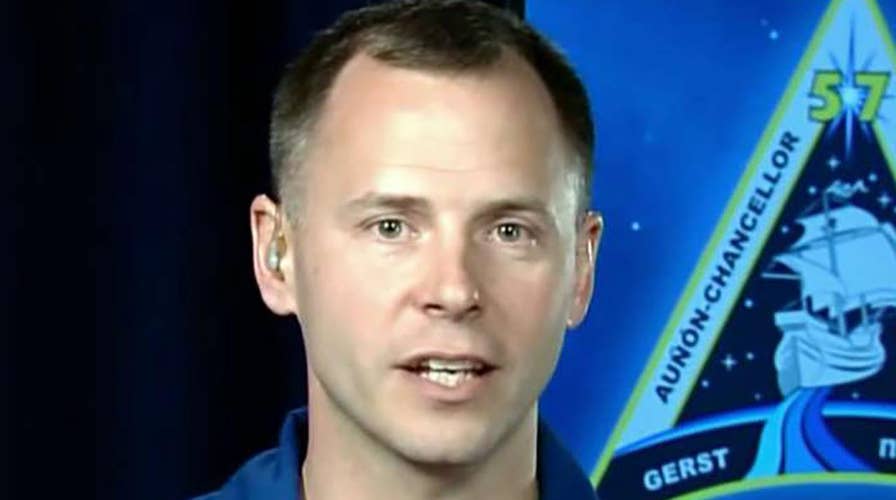NASA astronaut Nick Hague has described his dramatic escape from a failed Soyuz rocket just minutes after its launch last week.
After blasting into the sky from the Baikonur Cosmodrome in Kazakhstan, a problem with the separation of first and second stage booster rockets forced Hague and Russian cosmonaut Alexei Ovchinin to make a dangerous “ballistic re-entry” into Earth’s atmosphere.
“Right around the first stage separation everything went a little awry,” Hague explained, in a NASA interview. “We were tossed back and forth inside the capsule a little bit and thrusted away from the rocket as soon as the launch abort system had recognized there was a problem with the booster.”
U.S., RUSSIAN ASTRONAUTS MAKE DANGEROUS 'BALLISTIC RE-ENTRY' INTO EARTH'S ATMOSPHERE
Hague described the capsule being “ripped away” from the Soyuz rocket. “We had an alarm inside the capsule and we had an emergency light come on that said that we had had a problem with the booster,” he said. “At that moment, it was a pretty crystal clear realization that we weren’t going to make it to orbit that day.”
Hague and Ovchinin were on a mission to the International Space Station.
Russian space agency Roscosmos said the launch went wrong after one of the rocket's four boosters failed to jettison. The failure damaged the main stage and triggered the emergency landing.
SOYUZ ROCKET FAILURE: BOOSTER SEPARATION WAS TO BLAME FOR BOTCHED LAUNCH, RUSSIA SAYS
“I just remember it being this very poignant realization that ‘Wow, we just had a failure of the booster!’” Hague said. “So there’s a little bit of disbelief because it hasn’t happened in 35 years, so that was a little surprising.”
The astronaut said that his experience as a U.S. Air Force pilot and his astronaut training helped him deal with the rocket’s failure. “My career in the Air Force has done a lot to help me prepare for stressful situations like this, whether it’s through deployments or my time in flight test where we have had to deal with failures in aircraft that you’re in and having to get down on the ground immediately,” he said. “We train endlessly to address those types of situations. I have spent the better part of the last two years in Star City, Russia, inside a descent module where they have thrown every failure imaginable at us.”
The spacecraft was about 30 miles above Earth’s surface when the crew made their re-entry into Earth’s atmosphere. After the successful deployment of its parachute, the rescue capsule landed safely in the steppes of Kazakhstan about 30 minutes after the rocket failure.
NASA EYES STUNNING 'CLOUD CITY' AIRSHIP CONCEPT TO EXPLORE VENUS
Ballistic re-entry uses atmospheric drag to slow the spacecraft and can expose crewmembers to G-forces 10 times great than those on Earth, according to New Scientist. In televised remarks last week, Oleg Orlov, the head of the Institute for Medical and Biological Problems, Russia's top space medicine research center, said that the astronauts endured six Gs during the sharp ballistic descent. He added that space crew is trained to endure such load.
Normal Soyuz returns have G-forces of about five.
Hague said that the crew did not experience any extreme temperatures during their journey back to Earth. “If you look at pictures of our capsule laying on the steppes of Kazakhstan you realize that we weren’t going fast enough for anything to char, to have any of the plasma that you would normally have from a re-entry,” he explained. “We were going slow enough, our energy was low enough, that it was really just aerodynamic drag that slowed us down.”
NASA'S PARKER SOLAR PROBE GETS CLOSER TO 'TOUCHING THE SUN'
The astronaut did feel pressure changes during the capsule’s descent. “After the main chute opens, there is a valve that helps equalize us with the outside ambient air pressure and so you feel pressure changes in your ear on descent, just like you might feel in a commercial airliner coming in for landing,” he said.
Despite his dramatic escape last week, Hague is eager for his next opportunity to launch into space. “I am ready to go,” he said. “Personally, I feel like this is just another event that has happened that is going to help shape me and make me a more effective crew member in the future. Alexei and I, as a crew, we have experienced this together and that’s only going to make us a stronger crew in the future.”
The Associated Press contributed to this article.
Follow James Rogers on Twitter @jamesjrogers





















